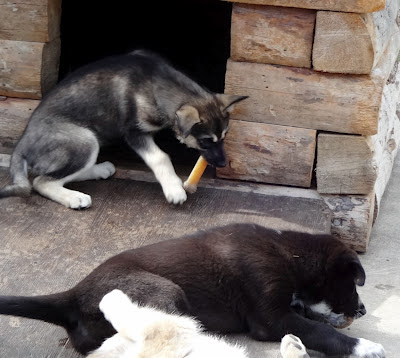The park has sled dogs to use for carrying supplies in the park once snow begins to fall and through the winter and into spring. I was curious to find out the differences between these dogs and the racing dogs that I learned about at the Seavey center in Seward.
. From May to mid-September, the park offers free tours at 10 a.m. and 2 p.m. Buses start to run from the park visitors' center area to the dog area (about 2 milsl away) 40 minutes before the demonstration. One does not have to be there 40 minutes in advance as the bus returns for more passengers, but people that go early have a better chance to visit the dogs by their kennels and also talk to the volunteers/workers.
Since I got there 30 minutes before the show/explanation, I got to visit with the dogs. We (the first bus load of people) were told that some of the dogs love attention, others just want their own space, and others need more privacy such as the puppies so are behind chain link fences.
 |
| Dog, who likes attention, resting on its kennel |
 |
| Lucor barking at men nearby |
 |
| One of my favorite shots--doggie snoozing |
The dogs are all groomed regularly.
These particular dogs are bred to hvae large compact feet to distribute the weight of the dogs evenly as they run through the snow. Because their feet are compact, snow does not accumulate between their toes.
The puppies were 7 to 8 weeks old and much bigger than the 4 to 5 week old ones I say in Seward. That is in part because these dogs are bred to pull lots of weight on sleds, so they average about 70 lbs in adulthood.
 |
| Puppies |
 |
| Puppy sunbathing! |
http://go.nps.gov/pups
These dogs weigh around 70 lbs which is at least 15 lb more than the dogs in races. They both are Alaskan huskies, but each breeder makes the dog to fit the qualities that s/he needs (including hauling, work, or racing), so there is no such thing as an Alaskan Husky purebred and therefore are not recognized by the American Kennel Club. However, they are distinct from any other dog breed. Their genetic history contains breeds such as Malamute,Samoyed, and Siberian Husky. (information from a sign on site.)
 |
| Dog resting next to staff person |
During the demo, we were lined up in rows in the special audience area. Only the first row had a few seats. The stands were terraced but it was still hard to see from any row beyond the second.
The speaker talked for about 10 minutes. Then they chose dogs, hitched them their spots and ran them around a circle once, maybe a total of 2 or 3 blocks.
When they brought them to the sleigh to attached them, they pulled them on their hind legs so that they would not step on their front paws.
There were about 8 or 10 dogs hitched up.
He spoke a bit afterwards too and answered a few questions. The dogs rested and were petted.
Different dogs run at 2 p.m. The afternoon group was much bigger and my friend decided not to wait in line to go.
There were a number of signs up that explain the dogs, their build, the sleds, etc. It was hard for me to get good photos of the signs because of the lighting in the building.
There was also a nice display of equipment (with signage) inside a small building. There is a great poster on display and for sale of the dogs currently at this site.
Dogs in a little usually are named based on a theme. The dogs below are the strongest and have volcanic-themed names. They were born in 2008..
Also, there were some good books for sale and I bought one of the Dogs of Denali Park.
After the presentation, one can walk around the area again and see dogs. Since I had had plenty of doggie time before the show, I got on the first bus for the ride back.
Here is the website: http://www.nps.gov/dena/planyourvisit/sled-dog-demonstrations.htm
 |
| One last photo: Can we run already??? |









No comments:
Post a Comment